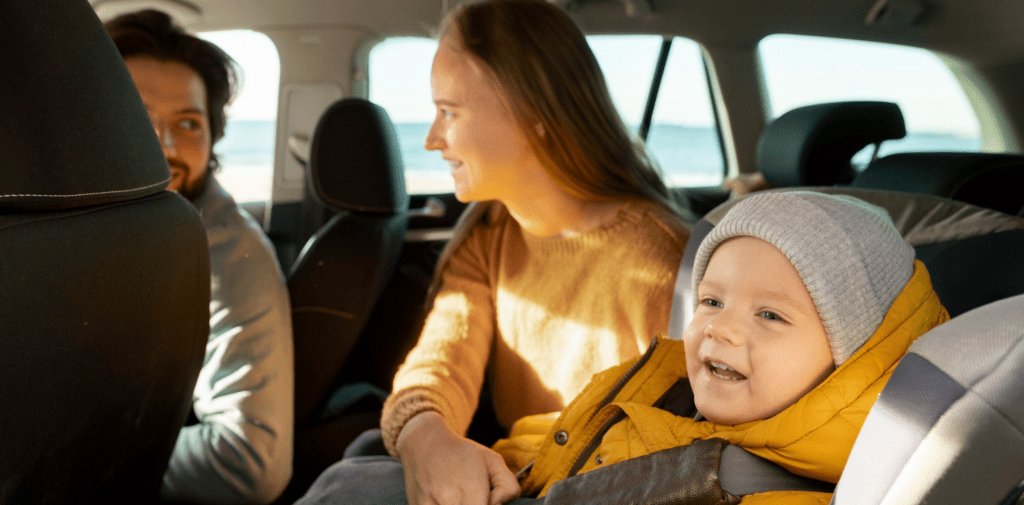
Driving with children requires a thorough understanding of safety rules and legal requirements to ensure their protection.
As parents, it’s crucial to know the legal obligations surrounding child car seats and how to choose the appropriate seat based on your child’s height and age.
This article will guide you through the essential information you need to know when driving with children in the UK.
Understanding the Rules
In the UK, the rules regarding child car seats are designed to ensure the highest level of safety for children.
The regulations stipulate that all children must use a child car seat until they are either 135 cm tall or 12 years old, whichever comes first. Understanding these rules is the first step in ensuring your child’s safety on the road.
Legal Requirements for Child Car Seats
Child car seats must meet specific legal requirements. In the UK, there are two main standards:
- R44/04: This is the older regulation which categorises seats by weight.
- R129 (i-Size): The newer standard that categorises seats by height.
Both standards are currently legal, but i-Size seats are generally considered safer due to improved side-impact protection and mandatory rear-facing positions for younger children.
It’s important to ensure that any car seat you purchase is approved under one of these regulations. The seat should have a label showing an “E” mark and the regulation it meets.
Age and Height Regulations
Children must use a child car seat until they reach 135 cm in height or their 12th birthday, whichever comes first. After this, they must use an adult seat belt. Here’s a breakdown of the stages:
- Babies (up to 15 months): Must be in a rear-facing car seat.
- Toddlers (15 months to 4 years): Can move to a forward-facing seat but it’s recommended to keep them rear-facing as long as possible.
- Young children (4 to 12 years): Use a high-back booster seat or booster cushion.
Penalties for Non-Compliance
Failing to comply with child car seat laws can result in serious consequences. If a child is not correctly restrained:
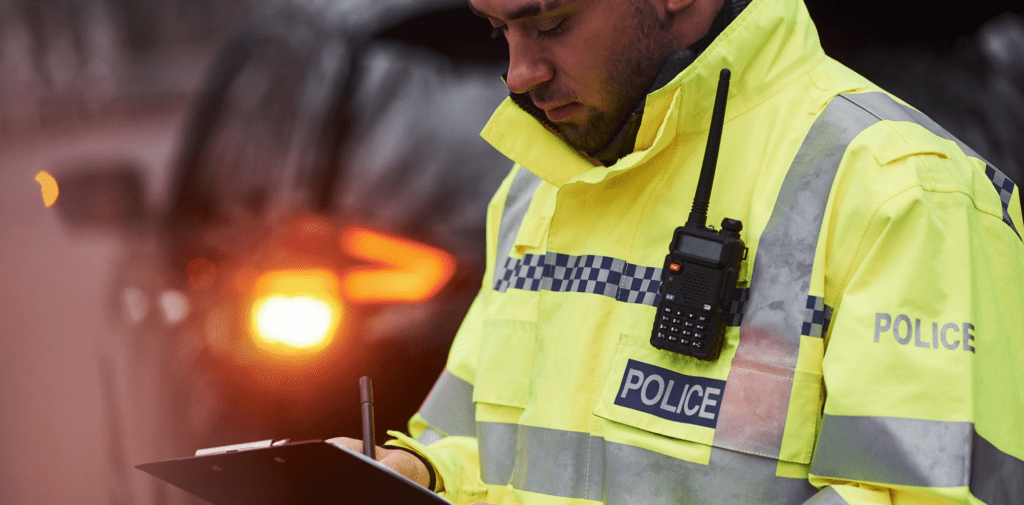
- You could receive a £100 on-the-spot fine.
- If the case goes to court, the fine could rise to £500.
Moreover, in the event of an accident, improper use of car seats can lead to severe injuries or fatalities, which is why adherence to these laws is critical.
Child Car Seats Based on Height
Choosing the right child car seat based on your child’s height is essential for their safety. Height-based seats, also known as i-Size seats, ensure that the car seat fits your child properly throughout their development stages.

Height-Based Seat Categories
Height-based car seats are divided into several categories:
- Rear-facing infant seats: Suitable for children up to 15 months.
- Rear and forward-facing seats: Suitable for children from 15 months to 4 years.
- High-back booster seats: Suitable for children from 4 to 12 years or until they reach 135 cm in height.
When to Transition to the Next Category
Knowing when to transition your child to the next seat category is crucial. The general rule is to follow the height and weight limits specified by the car seat manufacturer.
- Infant to toddler seats: Transition when your child exceeds the maximum height or weight limit for the infant seat, usually around 15 months.
- Toddler to high-back booster seats: Move to a high-back booster when your child is too tall for their current seat but not yet tall enough to use the vehicle’s seat belt alone, typically around 4 years old.
- High-back booster to seat belt: Once your child is 135 cm tall or 12 years old, they can safely use an adult seat belt.
Ensuring Proper Fit for Height-Based Seats
For a car seat to be effective, it must fit your child properly. Here are some tips:
- Head position: Ensure the child’s head is supported correctly. The top of the car seat should be above their ears.
- Harness fit: The harness should be snug but not too tight. You should be able to fit two fingers between the child’s chest and the harness.
- Seat belt fit: For booster seats, ensure the seat belt lies flat across the child’s chest and shoulders, not the neck, and the lap belt fits across the upper thighs, not the stomach.
Taking these steps will help ensure that the car seat provides the maximum protection for your child.
Additional Considerations
While height is a crucial factor, other considerations can help ensure the optimal safety of your child in a car seat. These include the following:
-
Car Compatibility: Ensure the car seat is compatible with your vehicle. Some seats are designed to fit specific car models or may require additional accessories for secure installation.
-
Ease of Use: Choose a car seat that is easy to install and adjust. A seat that is difficult to use increases the risk of incorrect installation.
-
Comfort: Consider the comfort of the car seat. A comfortable seat is more likely to be used correctly and consistently.
-
Safety Features: Look for car seats with additional safety features such as side-impact protection, energy-absorbing foam, and adjustable headrests.
-
Longevity: Some car seats are designed to grow with your child, offering multiple modes of use from infancy through early childhood. These can be more cost-effective and ensure a consistent level of safety.
By understanding the rules and ensuring that you choose and use the right child car seat based on your child’s height, you can significantly enhance their safety while driving.
Child Car Seats Based on Weight
While height-based seats (i-Size) are increasingly popular, weight-based car seats remain widely used and offer an alternative method for determining the appropriate car seat for your child.
Understanding the different weight categories can help you make an informed decision about the best car seat for your child’s needs.
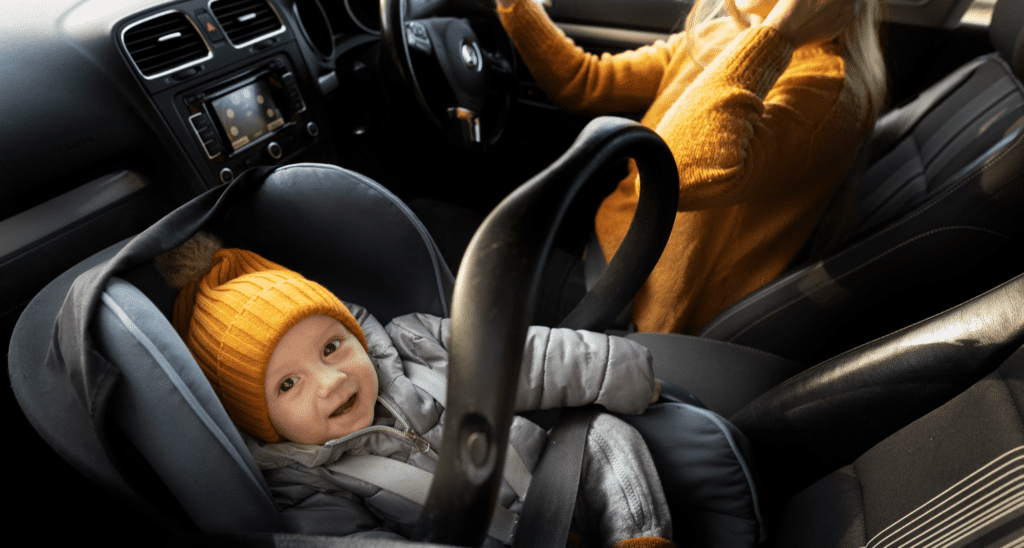
Weight-Based Seat Categories
Weight-based car seats are categorised into groups, each designed for specific weight ranges:
- Group 0: Up to 10 kg (approx. birth to 6-9 months)
- Group 0+: Up to 13 kg (approx. birth to 12-15 months)
- Group 1: 9-18 kg (approx. 9 months to 4 years)
- Group 2/3: 15-36 kg (approx. 4 to 12 years)
Comparing Weight vs. Height Criteria
Choosing between weight-based and height-based criteria can be challenging. Here are some key differences to consider:
-
Simplicity: Height-based seats offer a simpler approach as parents can easily measure their child’s height. However, weight-based seats provide a clear progression based on growth.
-
Safety: Both criteria are designed to ensure safety. i-Size seats often incorporate more advanced safety features like improved side-impact protection and rear-facing positions for longer periods. Weight-based seats are well-tested and widely used, providing reliable safety.
-
Compatibility: Height-based seats are generally designed to fit newer cars with ISOFIX points, while weight-based seats may offer more flexibility with installation options.
Advantages of Weight-Based Car Seats
Weight-based car seats have several advantages:
-
Established Safety Standards: These seats have been used for many years and have well-established safety records.
-
Versatility: They often fit a broader range of vehicles, including older models without ISOFIX points.
-
Clear Progression: The weight categories provide clear guidelines for when to transition to the next seat, ensuring continuous protection as your child grows.
Group & Child’s Weight
Understanding the different groups of weight-based car seats can help you choose the right seat for your child’s specific weight range and developmental stage.

Group 0 and 0+ (Up to 13kg)
Group 0 and 0+ seats are designed for newborns and infants up to 13 kg. These seats are rear-facing and provide crucial support for a baby’s head, neck, and spine.
- Group 0: Suitable for infants up to 10 kg, typically until they are 6 to 9 months old. These seats are usually part of a travel system, allowing them to be attached to a pram or stroller chassis.
- Group 0+: Suitable for infants up to 13 kg, typically until they are 12 to 15 months old. They provide extended rear-facing support, which is the safest position for young babies.
These seats often come with additional padding and inserts to ensure a snug fit for newborns. It’s important to ensure that the car seat is installed correctly and securely, following the manufacturer’s instructions.
Group 1 (9-18kg)
Group 1 seats are forward-facing or convertible seats that can be used both rear-facing and forward-facing, suitable for children weighing 9-18 kg, which is approximately 9 months to 4 years old.
- Forward-Facing: Many Group 1 seats are forward-facing, providing a good balance of safety and comfort as your child grows.
- Convertible Seats: Some Group 1 seats can be used rear-facing initially and then converted to forward-facing as your child reaches the appropriate weight.
These seats come with a five-point harness system to secure your child safely. It’s advisable to keep your child rear-facing for as long as possible within the weight limit, as this position offers better protection in the event of a collision.
Group 2/3 (15-36kg)
Group 2/3 seats are high-back booster seats designed for older children weighing 15-36 kg, typically from 4 to 12 years old.
- High-Back Booster: Provides support and positioning for the seat belt, ensuring it fits correctly over your child’s shoulder and lap.
- Booster Cushion: A simpler option without a back, suitable for older children who no longer need the additional head and side protection.
These seats are designed to lift the child to a height where the adult seat belt fits properly. The seat belt should lie flat across the chest and shoulder, not the neck, and the lap belt should fit snugly across the upper thighs, not the stomach.
Additional Considerations for Weight-Based Car Seats
When choosing a weight-based car seat, consider the following:
- Ease of Installation: Ensure the seat is easy to install and fits securely in your vehicle. Mis-installation can compromise safety.
- Adjustability: Look for seats that offer adjustable features such as harness height and recline positions to accommodate your child’s growth.
- Comfort: A comfortable seat is more likely to be used correctly and consistently. Look for seats with ample padding and ergonomic designs.
- Side-Impact Protection: Additional side-impact protection can offer enhanced safety in the event of a collision.
- Durability: Choose a seat made from high-quality materials that will withstand the rigours of daily use over several years.
By considering these factors and understanding the specific weight categories, you can ensure that you choose the safest and most appropriate car seat for your child’s needs.
Fitting a Child Car Seat
Ensuring that your child car seat is properly fitted in your vehicle is essential for your child’s safety. A correctly installed car seat can make a significant difference in protecting your child during a journey.
Here, we’ll discuss how to choose the right car seat for your vehicle, steps for secure installation, and common mistakes to avoid.
Choosing the Right Car Seat for Your Vehicle
Not all car seats fit all vehicles, so it’s crucial to choose one that is compatible with your car.
-
Check Compatibility: Before purchasing a car seat, check the manufacturer’s guidelines to ensure it fits your specific vehicle model. Some car seats are designed to fit certain cars better than others.
-
ISOFIX vs. Seat Belt: Decide whether you will use an ISOFIX or a seat belt installation. ISOFIX is generally easier and reduces the risk of incorrect installation, but not all vehicles have ISOFIX points. Ensure your car has ISOFIX points if you plan to use this method.
-
Space Considerations: Ensure the car seat fits well within your car’s interior. Some car seats are bulkier and might not fit well in smaller cars. Check that the seat doesn’t interfere with the front seats and that there’s enough room for other passengers.
-
Try Before You Buy: If possible, try fitting the car seat in your car before purchasing. Many retailers allow you to test the fit to ensure it works with your vehicle.
Steps to Install a Car Seat Securely
Proper installation of a child car seat is critical for safety. Follow these steps to ensure your car seat is installed correctly:
-
Read the Manual: Always read both the car seat and vehicle manuals. They provide specific instructions and safety warnings.
-
Positioning: Place the car seat in the correct position. Rear-facing seats should be installed in the back seat. Front-facing seats should also be in the back seat, but if absolutely necessary, ensure the front passenger airbag is deactivated.
-
Secure the Seat: If using a seat belt, thread it through the correct path on the car seat, ensuring there are no twists. Buckle the seat belt and pull it tight. For ISOFIX, attach the connectors to the ISOFIX points and push until you hear a click.
-
Check Tightness: The car seat should not move more than an inch side-to-side or front-to-back. Use your weight to push down on the car seat while tightening the seat belt or ISOFIX to ensure a snug fit.
-
Harness Adjustment: Adjust the harness so it fits your child snugly. The harness should be at or just below your child’s shoulders for rear-facing seats, and at or just above the shoulders for forward-facing seats.
Common Installation Mistakes to Avoid
Avoiding common mistakes can ensure the effectiveness of your car seat:
-
Loose Installation: Ensure the car seat is tightly secured. A loose car seat can move in an accident, reducing its effectiveness.
-
Incorrect Harness Position: The harness should be properly positioned on your child’s shoulders and chest. Incorrect positioning can lead to injuries.
-
Twisted Straps: Make sure the harness and seat belt are flat and not twisted. Twisted straps can reduce the effectiveness of the car seat.
-
Using Expired Seats: Car seats have an expiration date. Over time, the materials can degrade, and newer safety standards may make older seats less effective.
-
Rear-Facing Seats in the Front: Avoid placing rear-facing seats in the front seat with an active airbag. The force of the airbag can cause severe injuries in an accident.
Tips for Driving with Children
Driving with children requires preparation to ensure a safe and smooth journey. From preparing for the trip to keeping children entertained and managing behaviour, these tips can help make your travels more enjoyable.
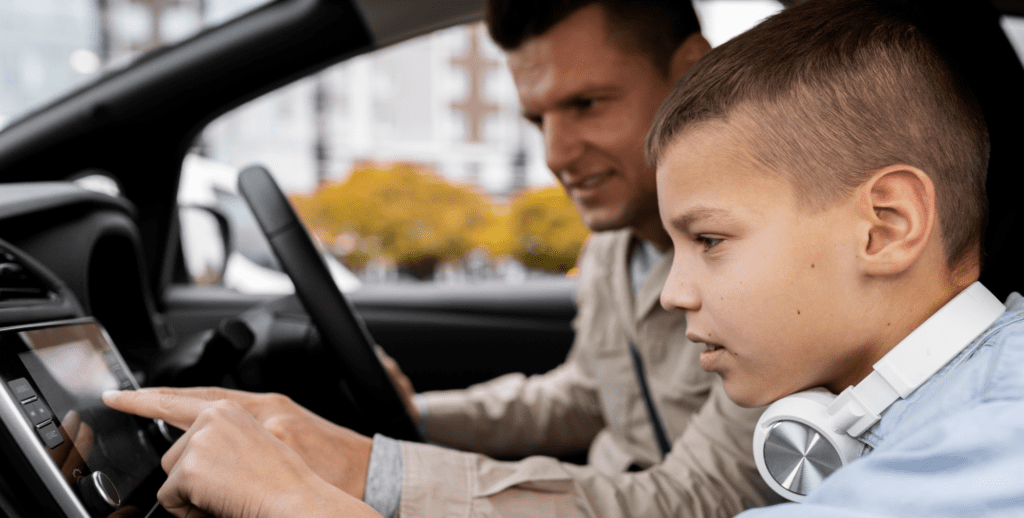
Preparing for the Journey
Preparation is key to a successful journey with children:
-
Plan Ahead: Plan your route and schedule breaks. Knowing where you can stop for bathroom breaks or to let the kids stretch their legs can make the trip more comfortable.
-
Pack Essentials: Bring all necessary items, including snacks, drinks, toys, and emergency supplies. Ensure you have nappies, wipes, and a change of clothes for younger children.
-
Comfortable Clothing: Dress your children in comfortable, weather-appropriate clothing. Layers can help adjust to changing temperatures.
-
Safety Check: Check that all car seats are properly installed and that you have the necessary equipment, such as first-aid kits and spare tyres.
Keeping Children Entertained
Keeping children entertained can help prevent restlessness and make the journey more pleasant:
-
Toys and Books: Bring a selection of toys and books to keep your children occupied. Quiet toys are ideal for avoiding distractions.
-
Electronic Devices: Tablets or portable DVD players can be lifesavers on long trips. Load them with your child’s favourite movies, shows, or educational games.
-
Interactive Games: Engage in car games like “I Spy” or “20 Questions” to keep your children mentally stimulated and entertained.
-
Music and Audiobooks: Create a playlist of their favourite songs or choose age-appropriate audiobooks to keep them engaged.
Managing Behaviour and Distractions
Managing your child’s behaviour and minimising distractions can help you focus on driving safely:
-
Set Expectations: Before you start the journey, explain to your children what to expect. Discuss the importance of staying seated and behaving well.
-
Frequent Breaks: Schedule regular breaks to allow your children to move around, use the bathroom, and release pent-up energy.
-
Positive Reinforcement: Praise good behaviour and use positive reinforcement to encourage your children to follow the rules.
-
Emergency Procedures: Teach your children what to do in case of an emergency. This includes staying calm and knowing how to alert you if they need help.
-
Stay Calm: If your child becomes disruptive, try to stay calm. Pull over safely if needed to address the situation rather than attempting to manage it while driving.
By following these tips and ensuring that your child car seat is properly installed, you can make your journeys safer and more enjoyable for everyone involved.
Safety Features to Look For in Car Seats
Choosing a car seat with the right safety features can significantly enhance your child’s protection during travel. Here are some essential features to consider when selecting a car seat.
ISOFIX Compatibility
ISOFIX is a standardised car seat attachment system that makes installation simpler and more secure.
- Easy Installation: ISOFIX car seats click directly into compatible points in the vehicle, reducing the risk of incorrect installation.
- Improved Stability: The rigid connection between the car seat and the vehicle structure enhances stability and reduces forward and sideways movement in a crash.
- Compatibility: Ensure your car has ISOFIX points. Most modern cars are equipped with them, but it’s always good to check your vehicle manual.
Side Impact Protection
Side impact protection is a crucial feature that can provide additional safety in the event of a side collision.
- Enhanced Safety: Side impact protection systems absorb and distribute the force of a collision, protecting your child’s head, neck, and torso.
- Energy-Absorbing Materials: Look for car seats with energy-absorbing foam or materials that cushion the impact.
- Deep Side Wings: Car seats with deep side wings provide an extra layer of protection around your child’s head and body.
Recline and Adjustability Features
Adjustability and recline features are essential for maintaining comfort and ensuring the car seat grows with your child.
- Multiple Recline Positions: Seats with multiple recline positions can help maintain a comfortable and safe sleeping position for your child, reducing the risk of head flopping forward.
- Adjustable Headrests and Harnesses: These features ensure the car seat can be adjusted to fit your child as they grow, maintaining safety and comfort.
- Ease of Adjustment: Ensure that the car seat is easy to adjust. Some seats have one-hand adjustment mechanisms, making it convenient to adapt the seat while on the go.
Legal and Safety Considerations
Staying informed about legal and safety considerations ensures that you are always compliant with regulations and that your child is as safe as possible.
Understanding Safety Standards (e.g., R44/04 and R129)
There are two main safety standards for car seats in the UK:
- R44/04: This standard categorises car seats by weight and has been in place for many years. Car seats that meet this standard are still legal and widely used.
- R129 (i-Size): This is the newer standard, which categorises car seats by height. It includes enhanced safety features such as improved side-impact protection and requires rear-facing seats for children up to 15 months.
Understanding these standards can help you choose the best car seat for your child. R129 seats are generally recommended for their advanced safety features, but R44/04 seats remain a valid option.
Regularly Checking Car Seat Fit and Condition
Regular checks on your car seat can ensure it remains safe and functional:
- Fit Check: Periodically check that the car seat is still properly installed and that the harness fits your child correctly. Adjust the straps and harness as your child grows.
- Condition Inspection: Inspect the car seat for any signs of wear and tear, such as frayed straps or cracked plastic. Any damage can compromise the seat’s safety.
- Manufacturer’s Instructions: Follow the car seat manufacturer’s maintenance guidelines. Some parts may need regular tightening or adjustment to ensure optimal safety.
Registering Your Car Seat for Recall Notifications
Registering your car seat with the manufacturer is a vital step in staying informed about safety recalls and updates.
- Recall Notifications: By registering, you will receive notifications directly from the manufacturer if there are any recalls or safety notices concerning your car seat.
- Safety Updates: Manufacturers may provide updates or new safety guidelines based on the latest research and safety tests.
- Peace of Mind: Knowing you will be promptly informed of any issues can give you peace of mind and ensure you can take swift action if necessary.
Ensuring that your car seat meets safety standards, remains in good condition, and is equipped with the latest safety features will help protect your child on every journey.
Comfort and Convenience
Ensuring comfort and convenience in your car seat can make travelling more enjoyable for both you and your child. Here are some considerations for choosing a seat with comfort features and tips for managing long journeys.
Choosing Seats with Comfort Features
When selecting a car seat, look for features that enhance your child’s comfort. Seats with extra padding and soft, breathable fabrics can keep your child comfortable during long trips.
Adjustable headrests and armrests can add to their comfort by supporting their head and arms, especially when they fall asleep.

Some car seats come with built-in sunshades to protect your child from glare and UV rays, which is especially useful during summer travels.
Additionally, seats with ventilation systems help keep your child cool and comfortable in hot weather.
Tips for Long Journeys with Children
Preparing for long journeys requires a bit of planning to ensure a smooth and enjoyable experience. Start by planning your route and scheduling regular breaks to allow your child to stretch their legs and use the bathroom.
Pack a travel bag with essentials such as snacks, drinks, toys, and blankets to keep your child comfortable and entertained.
Interactive games and educational apps on a tablet can provide entertainment and keep your child engaged.
To help manage potential travel sickness, pack some ginger biscuits or motion sickness tablets, and keep the car well-ventilated.
Maintaining Cleanliness and Hygiene
Maintaining the cleanliness and hygiene of your child’s car seat is crucial for their health and comfort. Regularly vacuum the seat to remove crumbs and dirt, and wipe down surfaces with a damp cloth.
For deeper cleaning, refer to the manufacturer’s instructions on removing and washing the seat cover. Consider using protective seat covers that are easier to remove and wash.
Ensure that you regularly clean and disinfect high-touch areas like the harness and buckles to prevent the build-up of germs.
Keeping a small cleaning kit in the car with wipes, sanitiser, and a small brush can help manage spills and messes on the go.
Traveling with Multiple Children
Travelling with multiple children requires careful planning to ensure each child’s safety and comfort. Here are some tips on arranging multiple car seats, ensuring each child’s safety, and handling sibling interactions.
Arranging Multiple Car Seats
When arranging multiple car seats in your vehicle, it’s important to ensure they are installed securely and that there’s enough space for each seat.
Place younger children in rear-facing seats in the middle of the back seat if possible, as this is the safest spot in the vehicle. Older children in forward-facing seats can be placed on the outer seats.
Ensure that each car seat is properly installed according to the manufacturer’s instructions and that there is no interference between the seats.
If your vehicle does not have enough space, consider using a car seat that is designed to be more compact or checking if your vehicle can be fitted with additional ISOFIX points.
Ensuring Each Child’s Safety
Ensuring the safety of each child involves more than just proper installation. Regularly check that the harnesses and belts are correctly adjusted for each child’s size.
Each car seat should be appropriate for the child’s height and weight, and you should regularly reassess to make sure they haven’t outgrown their seats.
Teach older children to buckle themselves in correctly, but always double-check to ensure it’s done properly.
For young children who are prone to unbuckling themselves, consider using additional safety clips or covers to prevent accidental release.
Handling Sibling Interactions
Managing sibling interactions during car journeys can be challenging but is important for a peaceful trip.
Encourage positive interactions by providing shared activities, such as games that both can participate in. If conflicts arise, address them calmly and fairly, and set clear expectations for behaviour before the journey begins.
Separate siblings who tend to argue by placing their car seats apart if space allows. Bring along each child’s favourite toy or comfort item to keep them content.
Consider using backseat organisers to keep their items within reach and reduce arguments over shared space. Having a plan for dealing with disputes can make the journey smoother for everyone involved.
By focusing on comfort, convenience, and safety, you can ensure a pleasant and secure travel experience for your children, whether you’re going on a short trip or a long journey.
Proper planning and regular maintenance of car seats will help keep your children safe and comfortable on the road.
Educating Children About Car Safety
Instilling the importance of car safety in your children from an early age is crucial for their wellbeing
. By teaching them about seat belt safety, using role-playing scenarios for younger children, and encouraging older children to take an active role in safety, you can help ensure they understand and follow safety rules.
Teaching Seat Belt Safety
Seat belt safety is a fundamental aspect of car safety that children need to understand. Explain to your children why seat belts are necessary and how they help protect them in case of an accident.
Demonstrate the proper way to wear a seat belt, ensuring it lies flat across the chest and shoulders and snugly across the lap.
Emphasise that the seat belt should never be placed under the arm or behind the back, as this can lead to serious injuries.
Reinforce the habit by consistently checking that your children are properly buckled before every trip and praising them for doing it correctly.
Role-Playing Scenarios for Younger Children
Using role-playing scenarios can be an effective way to teach younger children about car safety.
Create simple, fun scenarios where they practice buckling up their seat belts or sitting quietly in their car seats.
You can also use toys and dolls to simulate these actions, helping your child understand the importance of staying secured in the car.
Role-playing can also include emergency scenarios, where you teach your child what to do if something unexpected happens, such as the car stopping suddenly or needing to exit the vehicle quickly.
Encouraging Older Children to Help with Safety
Encouraging older children to take an active role in car safety can help reinforce their understanding and responsibility.
Ask them to help younger siblings with buckling up or to check that everyone’s seat belt is fastened correctly before starting the car.
Involving them in safety checks, such as ensuring the doors are locked and the seats are secure, can also empower them and build good habits. Praise their efforts and explain how their actions contribute to everyone’s safety.
Emergency Preparedness
Being prepared for emergencies is essential when travelling with children. Keeping emergency supplies in the car, teaching children what to do in an emergency, and planning for unexpected stops can help you handle any situation that arises.

Keeping Emergency Supplies in the Car
Maintaining a stock of emergency supplies in your car can be a lifesaver. Ensure you have a well-equipped first aid kit, including bandages, antiseptic wipes, and pain relievers.
Keep a supply of water and non-perishable snacks in case you get stranded or face a long delay.
A thermal blanket, flashlight, and spare batteries are also important items to have on hand. For winter months, consider adding an ice scraper, gloves, and a small shovel.
Regularly check and update your emergency kit to ensure all items are in good condition and not expired.
Teaching Children What to Do in an Emergency
Educating your children on what to do in an emergency can help them stay calm and act appropriately.
Teach them how to dial emergency services and provide basic information, such as their location and the nature of the emergency.
Practice this regularly so they remember what to do under stress. Explain the importance of staying calm and following instructions given by adults or emergency responders.
Make sure they know not to leave the vehicle unless it is safe to do so and they are instructed by a trusted adult.
Planning for Unexpected Stops
Planning for unexpected stops can help you manage situations like car breakdowns or sudden illnesses.
Always have a list of emergency contacts and local services along your route. Identify safe places to stop, such as service stations or rest areas, where you can address any issues.
Keep a charged mobile phone and a car charger handy for communication and navigation.
If you need to make an unexpected stop, use your hazard lights to alert other drivers and ensure your children stay in the car or in a safe location away from traffic.
Having a clear plan can reduce stress and ensure you handle unexpected situations effectively.
By educating your children about car safety and being prepared for emergencies, you can create a safer travel environment for your family.
These proactive measures help ensure that you and your children are ready to handle any situation that arises while on the road.
Recommended Accessories for Child Passengers
Having the right accessories can enhance your child’s comfort and safety during car journeys. These accessories not only make the trip more pleasant but also help you stay organised and focused.
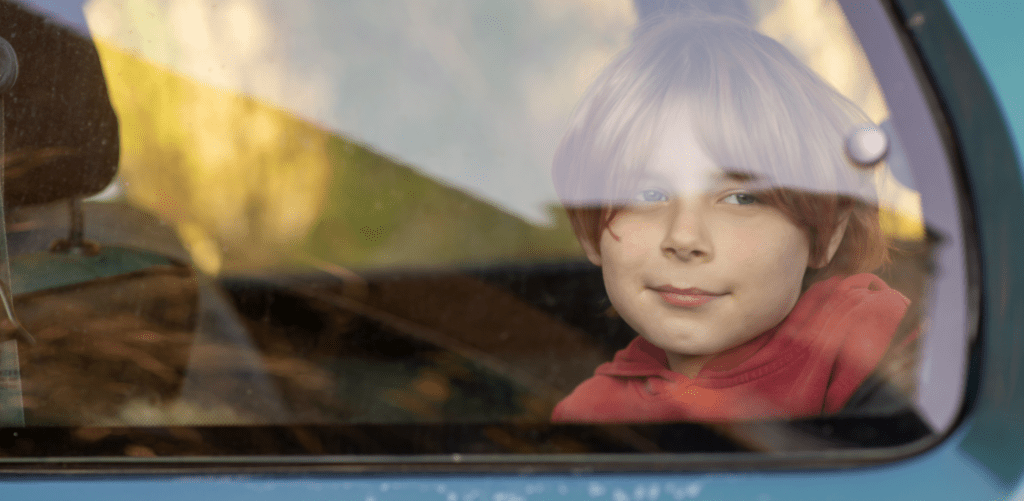
Window Shades and Sun Protection
Window shades are essential for protecting your child from the sun’s harmful rays. They help keep the car interior cooler and shield your child’s eyes from bright sunlight.
There are various types of window shades available, including static cling shades, roller shades, and retractable shades.
Choose shades that are easy to install and adjust, providing full coverage without obstructing your view. Additionally, consider using sun-protective films on your car windows for added protection.
These films reduce glare and block UV rays, contributing to a safer and more comfortable environment for your child.
Travel Pillows and Blankets
Travel pillows and blankets can significantly improve your child’s comfort during long journeys. A well-designed travel pillow supports your child’s neck and prevents discomfort or injury if they fall asleep.
Look for pillows that are soft, washable, and appropriately sized for your child. Similarly, keeping a cosy blanket in the car ensures your child stays warm and comfortable, especially during night trips or cooler weather.
Opt for blankets that are lightweight and easy to store, ensuring they don’t take up too much space when not in use.
Car Organisers and Storage Solutions
Keeping the car tidy and organised is crucial when travelling with children. Car organisers and storage solutions help manage toys, snacks, books, and other essentials, preventing clutter and ensuring everything is within easy reach.
Backseat organisers that hang over the front seat can hold a variety of items and keep them accessible to your child. Seatback protectors can also help keep your car clean from dirty shoes.
Trunk organisers and under-seat storage boxes are great for larger items and help maximise the use of space. An organised car not only looks better but also reduces distractions, allowing you to focus on driving.
Maintaining Focus While Driving
Staying focused on the road is critical for the safety of you and your passengers. Here are some techniques to minimise distractions, set rules and expectations before driving, and use technology safely.
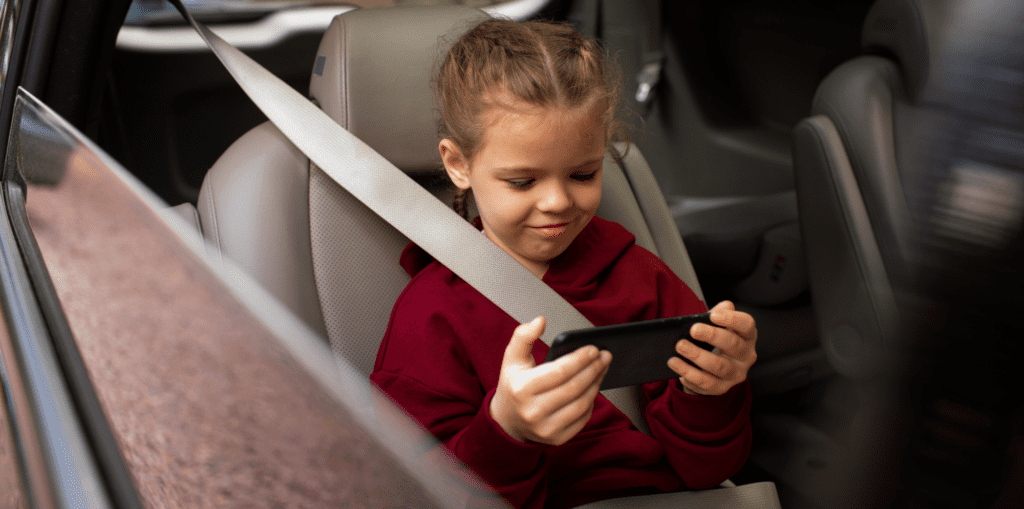
Techniques to Minimise Distractions
Minimising distractions is essential for safe driving. One effective technique is to keep essential items within easy reach so you don’t have to search for them while driving.
Use hands-free devices for phone calls and voice-activated controls for navigation and music. Organise your car in a way that reduces the need to reach back or look away from the road.
If your children need attention, it’s safer to pull over in a safe location rather than trying to handle their needs while driving. Encourage older children to assist with minor tasks like handing out snacks or adjusting volume levels.
Setting Rules and Expectations Before Driving
Establishing clear rules and expectations before setting off can help maintain order and reduce distractions.
Explain to your children the importance of staying seated with their seat belts fastened at all times. Set expectations about behaviour, such as using indoor voices and not fighting with siblings.
Discuss the plan for the journey, including scheduled breaks and what to do if they need something while you’re driving.
Reinforcing these rules regularly helps children understand and respect the boundaries, making for a smoother and safer trip.
Using Technology Safely
Using technology in the car can be both a benefit and a potential distraction. Utilise technology that aids in driving, such as GPS for navigation and Bluetooth for hands-free calls.
Ensure all technology is set up before you start driving, minimising the need to adjust settings while on the move.
For entertainment, use tablets or in-car DVD players to keep children occupied, but ensure these devices are securely mounted and do not interfere with your view or control of the vehicle.
Headphones can help keep the car quiet, allowing you to concentrate on driving. Always prioritise safety and avoid any technology that could divert your attention from the road.
By equipping your car with the right accessories and maintaining focus through effective strategies, you can create a safe and enjoyable environment for your child passengers, ensuring a stress-free driving experience.
Legal and Insurance Implications
Understanding the legal and insurance implications related to child car seats is crucial for ensuring compliance and protecting your family in case of accidents.

Knowing how child seats affect insurance, the process for reporting accidents involving children, and the importance of keeping insurance information updated can save you time and trouble.
Understanding How Child Seats Affect Insurance
Child car seats can have various impacts on your car insurance. Many insurance companies view the use of appropriate child car seats favourably, as they significantly reduce the risk of injury in an accident.
Some insurers might offer discounts or incentives if you have high-quality, certified child seats installed in your vehicle.
In the event of an accident, insurers will check whether a legally compliant child car seat was in use.
Using a child car seat that meets the latest safety standards, such as R129 (i-Size), can also be beneficial in claims processes.
Failing to use a compliant car seat, or using one incorrectly, can lead to complications with claims and potential reductions in payouts.
It’s important to inform your insurer about the car seats you use and keep any documentation about their compliance and installation as part of your insurance records.
Reporting Accidents and Incidents Involving Children
If you are involved in an accident with children in the car, it is crucial to handle the situation correctly. Firstly, ensure that everyone is safe and seek medical attention if necessary.
Contact the police to report the accident, especially if there are injuries or significant damage.
When reporting the incident to your insurer, provide detailed information about the child car seats used, including their make, model, and installation method.
Mention whether the seats were occupied at the time of the accident and if they sustained any damage.
Even minor accidents should be reported, as car seats can be structurally compromised even without visible damage.
Many manufacturers recommend replacing car seats after any collision, as their integrity might be affected.
Check your car seat’s manual for specific advice and report this to your insurer. Document all details and keep records of communications with your insurer and the police for future reference.
Keeping Insurance Information Updated
Maintaining up-to-date insurance information is essential for ensuring continuous coverage and avoiding complications.
Regularly review your policy details, especially after significant changes such as purchasing new car seats or vehicles.
Inform your insurer of any changes in your family situation that might affect your policy, such as the addition of new children who will be using car seats.
Provide updated information on the car seats you use, including any upgrades to models that meet newer safety standards.
Keeping your insurer informed about your compliance with safety regulations, such as using approved car seats, can help ensure that you are fully covered in the event of an accident.
Also, make sure to update your insurer with any changes to your contact information or address to ensure you receive all necessary communications and documents.
By understanding how child seats affect your insurance, properly reporting accidents involving children, and keeping your insurance information up to date, you can navigate the legal and insurance aspects more effectively, ensuring your family’s safety and financial protection.
Frequently asked questions
In the UK, children must use a child car seat until they are 135 cm tall or 12 years old, whichever comes first. The car seat must be appropriate for the child’s height or weight and must be correctly installed according to the manufacturer’s instructions.
- Height-based car seats (i-Size) are categorised by the child’s height and are designed to keep children rear-facing until they are at least 15 months old.
- Weight-based car seats are categorised by the child’s weight and follow the older R44/04 regulation. Both types are legally acceptable, but i-Size seats often have enhanced safety features.
For height-based seats, transition your child when they outgrow the height limit specified by the manufacturer.
For weight-based seats, move to the next category when your child exceeds the maximum weight limit of their current seat. Always follow the manufacturer’s guidelines.
If a child is not properly restrained in a car seat, you could face an on-the-spot fine of £100. If the case goes to court, the fine could increase to £500. More importantly, incorrect use can significantly increase the risk of injury in an accident.
Using a second-hand car seat is generally not recommended unless you are certain of its history. Ensure it has not been involved in an accident, is not expired, and meets current safety standards. It’s best to purchase a new car seat to ensure maximum safety.
Always follow the manufacturer’s installation instructions carefully. Make sure the seat is securely fastened with the seat belt or ISOFIX points.
The car seat should not move more than an inch side-to-side or front-to-back when installed. Regularly check the fit and condition of the car seat.
If your child unbuckles their seat belt while driving, pull over safely as soon as possible and re-buckle it.
Explain the importance of staying buckled up for their safety. Consider using additional safety clips or covers to prevent young children from unbuckling themselves.
Yes, several accessories can enhance comfort and convenience.
- Window shades protect from the sun
- Travel pillows and blankets provide comfort
- Car organisers help keep the car tidy and essentials within reach.
Choose accessories that do not interfere with the car seat’s safety functions.
To keep your child entertained during long trips, bring a selection of:
- Toys
- Books
- Electronic devices loaded with games and videos
Plan interactive car games and have snacks ready. Regular breaks are also important to let children stretch and reduce restlessness.
Keep a well-equipped emergency kit in your car, including:
- A first-aid kit
- Water
- Snacks
- A thermal blanket
Teach your child what to do in an emergency, such as staying calm and calling for help if needed.
Plan your route to include safe stopping points and keep your mobile phone charged for emergencies.


